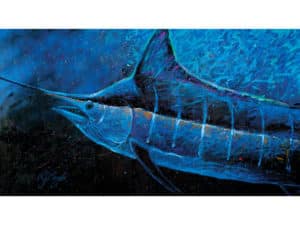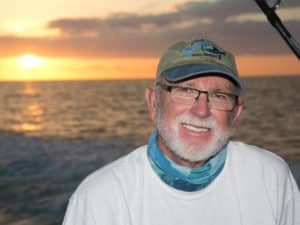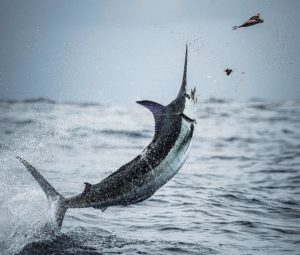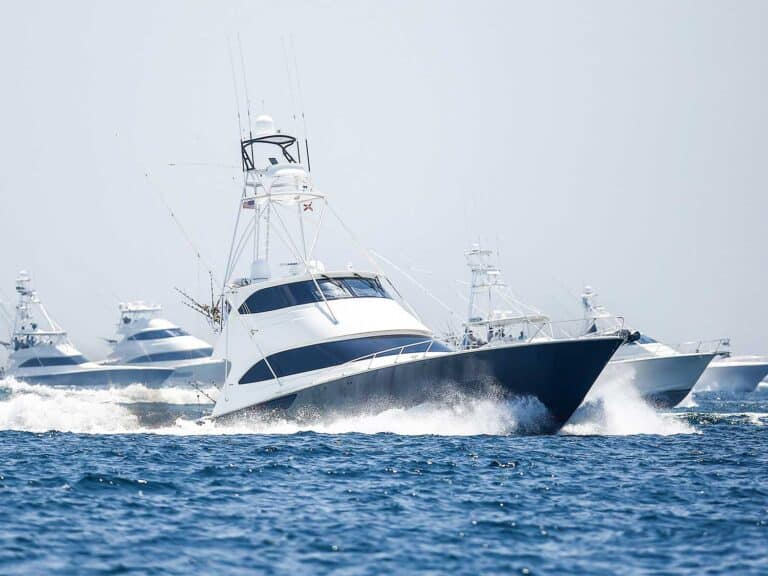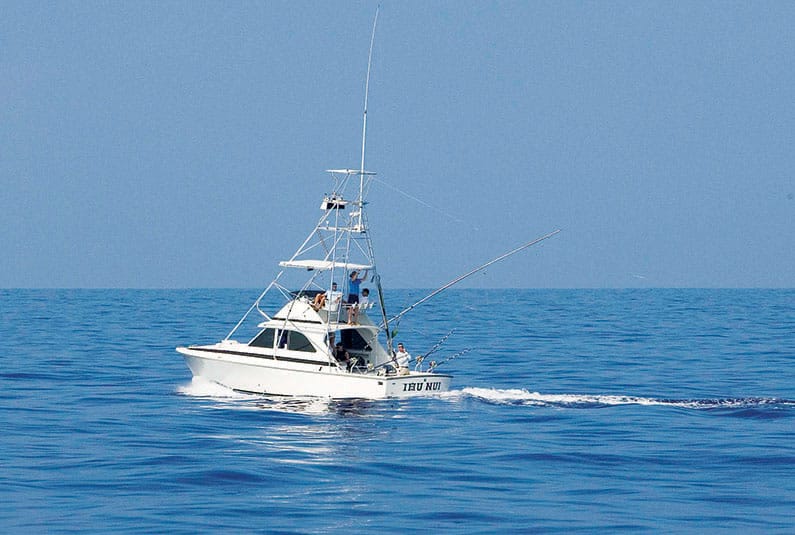
Taking Billfish in Kona
You probably know that Kona, Hawaii, is one of the top spots in the world to catch giant blue marlin. But did you know that top Kona captains and crews release many of their big fish? You probably did not. Big dead fish shots get a lot of attention in the mainstream media, whereas shots of released fish don’t. Here’s a story about captains releasing huge fish, even when they stood to gain from their capture.
I was recently fishing in Kona with Capt. Bomboy Llanes. While we were waiting for a tuna to hit a lure (and no, we wouldn’t have let that one go!), I got a text from Ryan O’Halloran, the mate on Capt. Chip Van Mols’ boat, who was fishing about 10 miles north of us, saying that Capt. Kevin Nakamaru on Northern Lights was hooked up to a big fish.
This piqued my interest, because O’Halloran has seen plenty of fish in the 800- to 1,200-pound range, in locations like Kona and the Great Barrier Reef. Reputable captains and crews in Kona don’t even say the word “big” unless it’s somewhere around 700 pounds. I think the code word for 600 pounds is “nice,” and 500 is considered “decent.” Nothing will lose you more respect in the close-knit fishing community than wrongfully claiming a grander. It’s the fishing equivalent of the “Dewey Defeats Truman” headline. O’Halloran’s “big fish” remark, therefore, carried some weight.
“Dude, are you serious? How big is the fish Kevin’s on?”
“It could go over the mark.”
My heart raced. “The mark” is code for over 1,000 pounds, a grander; getting one is the fishing equivalent of a Super Bowl victory. Kona is one of a handful of places in the world where fish of this size are caught regularly. It’s the ultimate goal of almost everyone who fishes for big game. Most never attain it.
We kept exchanging texts until O’Halloran informed me that Nakamaru and his angler had brought the fish boatside, taken some quick pictures and let it go.
The wind picked up, and Llanes and I had a wet ride back to Honokohau Harbor. I walked up the dock toward my car, where I spotted Nakamaru casually chatting with his mate and washing down his boat. No fanfare, no whooping and hollering that he’d just released a huge marlin that could have been the highlight of his career and a boon to his business; he was just acting like it was any other day. I asked him about the fish, and he showed me some pictures of it being released — pictures that would never be seen by the majority of people.
I’ve covered fishing in Kona for years, and the fact is, most charter boats in Kona elect to release most of the marlin they catch, and it bugs me that people assume the opposite. When I was in Kona last summer, for example, they weighed a 1,022-pound marlin, and it was one of the biggest stories in the world on mainstream websites for a couple of days. With all that Nakamaru stood to gain from keeping the fish, it’s pretty amazing that he chose to release it, and he’s not the only Kona captain to do so.
As a fishing writer and photographer (bluewaterjon.com), I see which stories make big news in the fishing and larger mainstream media, and I’ve noticed an interesting pattern: Big dead fish make big news, but big fish that are intentionally released go largely unnoticed. People complain about big fish being brought to the docks, but when a world-class captain like Nakamaru goes out of his way to let a huge one go, few make a big deal out of it.
So why don’t you hear about the big fish that get released? Why don’t people make a big deal out of it, and why doesn’t the news go viral, like shots of big dead fish? For starters, people who run the nonfishing mainstream websites know that if they have a picture showing the true size of a huge marlin — something that’s very hard to gauge until you bring it back to the dock, where it dwarfs the anglers who stand next to it — they’ll get a lot of hits.
More hits means more website traffic. More traffic means they can sell more ads. If you want to see fewer big dead fish shots, stop clicking on those stories and send a direct email to the author and the site’s editor letting them know what you think. Your complaints in the comments section of the story only help the story get more traction and views. The more comments and audience reaction, the more likely the editor will run similar stories in the future.
When captains, crews and anglers in Kona bring a huge marlin to the boat and release it, they have to concentrate on keeping the fish healthy, and they usually don’t have a dedicated photographer on board to take pictures from the boat deck or dive in and swim with the fish. As a result, their photos don’t have that wow factor for the average reader, so the bigger websites tend not to run them.
Sure, captains in Kona keep the occasional huge fish, but nothing goes to waste. Locals eat every bit of the fish, and with the price of fresh meat as high as it is in Kona, that marlin may be the only fresh fish — or any meat, for that matter -— they get to eat. On my recent visit to Kona, I was paying $14.99 a pound for plain old sandwich-grade turkey at the supermarket. It’s easy for people, particularly wealthy traveling anglers from the mainland United States, to wear a cloak of self-righteous indignation when they see people from Kona eating marlin, but for many people there, it’s how they put food on the table without literally having to eat spam.
It seems ridiculous to ask local Hawaiians to let every single fish go when their hook-and-line fishing tactics aren’t responsible for the world’s overfishing problem. If people want to stop overfishing and protect billfish stocks, they might better save their outrage for the commercial longline fleet — floating fish factories that use helicopters, giant nets and bottom trawlers that decimate stocks of billfish, tuna and other species on a global scale.
The problem, in my opinion, is that captains and crews are in a no-win situation. If they weigh a big fish, they can get press and more clients, a precious commodity in an economy where leisure activities like travel and big-game fishing have taken a hard hit.
On the other hand, if they weigh a fish, they get a lot of grief, sometimes even from people who have killed plenty of billfish themselves — either by weighing fish or by unwittingly fighting them to the point that they won’t likely survive release.
From what I’ve seen, none of the Kona captains are making a lot of money — far from it. It’s a tough job with long hours and requires skill learned over decades of training on the water. If they did it for anything other than the love of the sport, they’d have left the business a long time ago.
So, what might we learn from this? First, have some perspective. People still actually use fish as a means of subsistence in some parts of the world, and they can’t always afford to eat out or buy fresh meat or fish, so they catch their own. Self-sufficiency used to be an admirable trait.
Second, go out of your way to celebrate the stories and pictures of those who release big fish, even if the pictures and videos aren’t as eye-catching as those taken at the dock. Share news of their catch-and-release adventures. Contact the captains who release fish, give ’em a shout-out and like their Facebook pages.
Third, look within. If you release all of your billfish, are you doing it in a way that minimizes stress on the fish? That might require using heavier tackle and taking longer with each fish to revive it and/or cut the leader to a minimum or remove the hook. This might mean lower numbers.
And if captains from places like Kona keep the occasional marlin, get over it. Their impact on the fish population is a drop in the bucket. Unlike the often well-heeled traveling anglers to whom they cater, they’re not just fishing for trophies.
